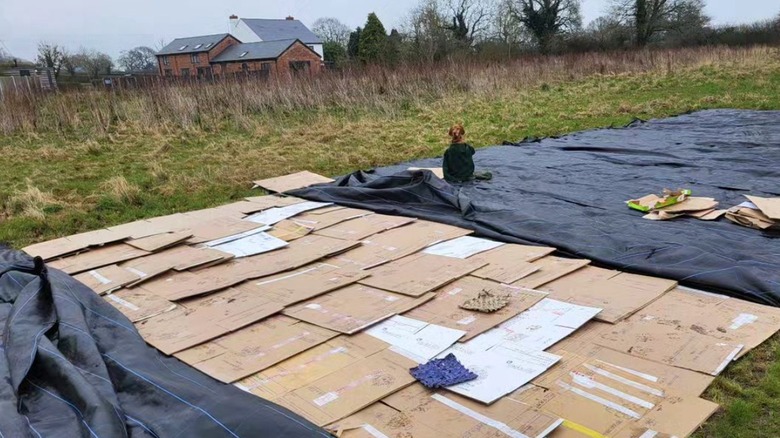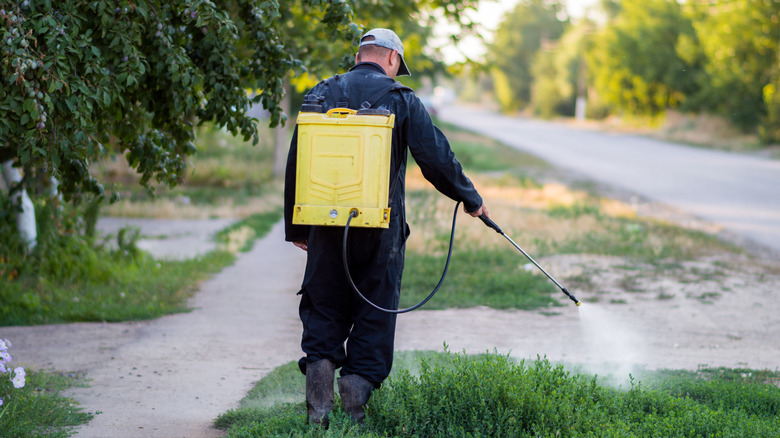Remove Pesky Couch Grass From Your Lawn With These Simple Tips
No, we are not talking about how your outdoor furniture gets grassy after mowing the lawn. Instead, we are discussing a common grass weed. Although it has a silly common name, elymus repens, or couch grass, is an invasive grass species from the United Kingdom. Per the Royal Horticultural Society (RHS), you can identify couch grass from its flattened green leaves and yellowish flowers, which pop up during the summer. The flora is an obvious sign of an infestation since your grass shouldn't flower. Further, RHS notes that this invasive species can grow up to three and a half feet tall if left unattended in a yard or garden.
Also known by names like quackgrass, dog grass, witch grass, and more, once you have an invasion of this particular weed, its root system makes it difficult to root out fully. Chris Hardie at the Wisconsin State Farmer outlined his own battle against couch grass in his garden. "It took us at least 12 hours spread out over the course of a week to work our way through the garden, bit by bit, fork by fork, wheelbarrow by wheelbarrow," Hardie wrote.
Digging out the root system of couch grass by hand is the most immediate (and cumbersome) way to remove it quickly. It is also one of the least harmful ways to kill weeds in your lawn. Still, while it is a pain once it takes root, there are a couple of other ways to remove couch grass from your lawn.
Eliminate couch grass by smothering
Much of the advice you'll find online for dealing with couch grass pertains to its pesky presence in gardens. That's because it is known as an allelopathic plant, which means it prevents other plants from growing nearby. Still, getting this invasive weed out of your yard is just as important because it can easily take over flower and vegetable gardens from there.
One way to stop an infestation in its tracks is by smothering it. After all, smothering is one of the easiest ways to kill the grass on your lawn. Cover the weedy area in a layer of newspaper or cardboard. Doing this will stop nutrients and light from reaching the plant, which will inevitably kill it. You can wet the paper materials to hold them in place and pile compost or fertilizer on top for good measure. Other green thumb soldiers in the fight against couch grass will also use weed fabric to stop even the toughest weeds from poking their way out of the smothering layers.
While this mode of diminishing couch grass will save a lot of energy, it won't save time. You'll have to keep the area of your yard covered for at least nine months to a year to stop it from coming back. After all, couch grass is perennial so it has a tendency to crop back up.
Spray the grass with an herbicide
As with many lawn and garden-related pests, applying an herbicide is a fast solution to a couch grass infestation. While not environmentally sound, like smothering or digging up the plants, turning to a chemical will do the job quickly and effectively. Per a trial by Which? Gardening, spraying glyphosate to couch grass killed the weed after just one application and kept it at bay the next year as well. Glyphosate is largely agreed upon as the go-to herbicide for dealing with couch grass, it is most commonly known as a primary ingredient in RoundUp.
Using a spray herbicide for couch grass is best done in the early spring when the weeds tend to take root. It should be noted, however, that glyphosate is such a powerful herbicide that it will kill any other plant it touches. So be careful during application on your lawn to avoid any undue spraying. For repeat regrowth, try spraying the couch grass regularly for two to three months to kill off the plant and root system fully. As you can see, removing couch grass from your lawn is a burdensome task, though far from impossible.



